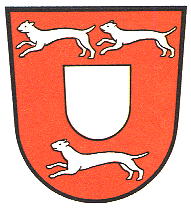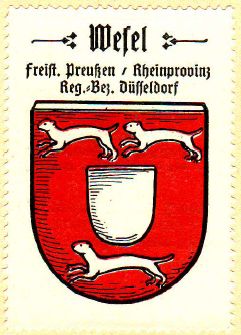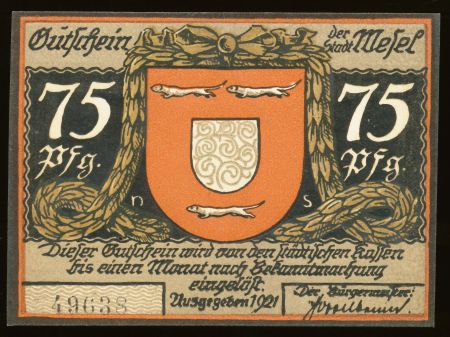Wesel: Difference between revisions
Knorrepoes (talk | contribs) |
Knorrepoes (talk | contribs) m (Text replace - "[[Literature" to "{{media}} [[Literature") |
||
| Line 22: | Line 22: | ||
|align="center"|[[File:wesel.ng.jpg|center]] <br/>The arms on emergency money, 1921 | |align="center"|[[File:wesel.ng.jpg|center]] <br/>The arms on emergency money, 1921 | ||
|} | |} | ||
{{media}} | |||
[[Literature]] : Stadler, K. : Deutsche Wappen - Bundesrepublik Deutschland. Angelsachsen Verlag, 1964-1971, 8 volumes. | [[Literature]] : Stadler, K. : Deutsche Wappen - Bundesrepublik Deutschland. Angelsachsen Verlag, 1964-1971, 8 volumes. | ||
Revision as of 08:57, 9 July 2014
| Heraldry of the World Civic heraldry of Germany - Deutsche Wappen (Gemeindewappen/Kreiswappen) |
WESEL
State : Nordrhein-Westfalen
District (Kreis) : Wesel (until 1974 Rees)
Additions : 1969 Flüren, Obrighoven-Lackhausen, 1975 Bislich, Büderich (1850 Ginderich), Diersfordt
Origin/meaning
The arms are mainly canting (Wesel = weasel).
A weasel already appears on the first known seal, which dates from the early 13th century. The main image of the seal shows a gate with Emperor Heinrich VII and Count Theodor of Kleve. Under the gate the weasel is seen. In 1269 on a smaller seal only the weasel appears. Both the large and smaller seals remain similar until the 16th century. In the 14th century arms with three weasels are mentioned (these never appeared on the seals). Around 1600 the weasels are placed on the original arms of the counts of Kleve.
| The arms in the Kaffee Hag albums +/- 1925 |
The arms on emergency money, 1921 |
Contact and Support
Partners:
Your logo here ?
Contact us
© since 1995, Heraldry of the World, Ralf Hartemink 
Index of the site
Literature : Stadler, K. : Deutsche Wappen - Bundesrepublik Deutschland. Angelsachsen Verlag, 1964-1971, 8 volumes.













